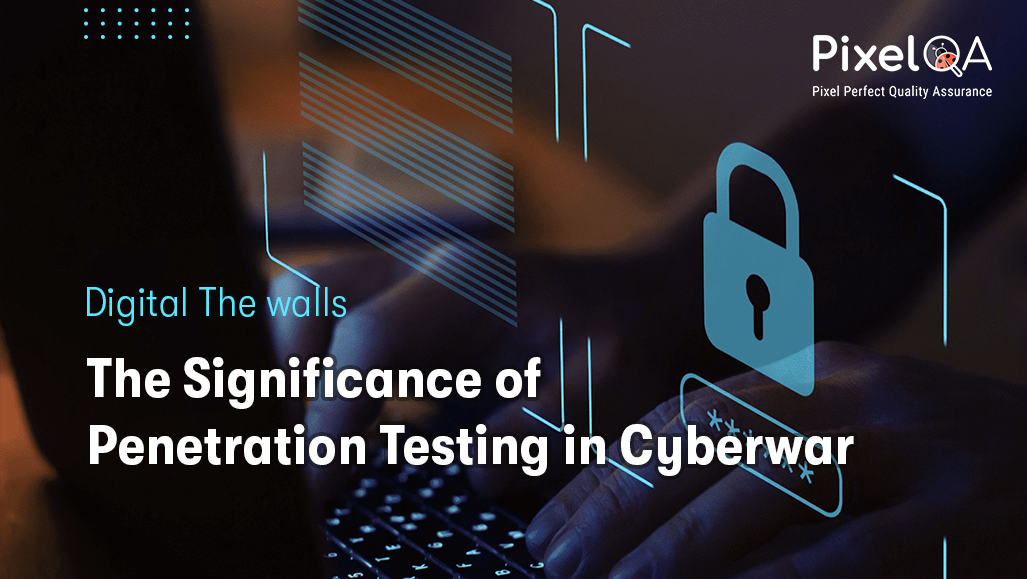
Data is the new gold in today's digital society. Everything is kept online, including government secrets and personal data. However, this ease of use also brings with it a brand-new form of conflict. Cybercriminals and hackers are always coming up with new ways to compromise networks and try to damage them. This is where penetration testing services, also known as pen testing, enters the play, serving as a digital soldier on the battlefield, protecting against invisible enemies.
Table of Content
- Explain Cyberwarfare
- Describe penetration testing
- Why Cyberwarfare Needs Penetration Testing
- Penetration Testing Types
- The Penetration Testing Process
- Tools Used in Pen Testing
- Hacking Ethics: The Good Guys in the Backfield
- The Evolving Purpose of Pen Testing
- Conclusion
Explain Cyberwarfare
Learning about cyber warfare is important before we start pen testing. Cyberwarfare is the employment of technology in attacking other countries, businesses, or individuals. These assaults could involve illicit activity, data theft, system crashes, or even platform modifications.
Cyberwar is waged in the online world as compared to traditional warfare, which is waged using tanks and soldiers. It can be done anywhere, at any time, and often without warning. Before the harm is inflicted, victims can even remain unaware that they have been struck.
Describe penetration testing
To find vulnerabilities before evil hackers do, penetration testing mimics a cyberattack against a system, network, or application. Think of paying someone to break into your home so you can boost your security, but only to inform you of how they did it.
The goal is to assess the effectiveness of your defenses. A hacker is probably capable of breaking in if a pen tester can. By fixing these vulnerabilities as soon as they are found, businesses can safeguard their priceless data.
Why Cyberwarfare Needs Penetration Testing
Penetration testing is a defensive tactic as well as an IT responsibility. Here's why it's so important in the modern digital battlefield:
1. Proactive Defense
Traditional cybersecurity often relies on reactive measures. This means security teams respond after an attack has occurred. Penetration testing flips this approach. It’s proactive. Instead of waiting for anything to go wrong, pen testers try to find problems before hackers do.
This is similar to sending spies to the enemy's camp to find out how they plan and construct more robust defenses.
2. Recognizing Threats in the Real World
Although automated measures such as firewalls and antivirus software are useful, they are unable to completely replicate the inventiveness of a human hacker. Pen testers have the mindset of actual attackers. They employ the same resources and methods as real hackers.
As a result, companies are better equipped to assess their actual level of vulnerability. Knowing that your home is secured with a lock is one thing, but knowing that someone can pick it up in less than five seconds is quite another.
3. Preserving Critical Infrastructure
Government agencies, banks, hospitals, and electrical grids rely on digital systems. Compromises to these could have catastrophic economic or deadly impacts. Threats within these critical infrastructures can be discovered through the use of penetration testing.
Imagine if a hacker compromises hospital patient information or disables the power to a city. These are not data breaches but acts of war. Pen testing helps to avert these incidents before they reach the level of being catastrophic events.
4. Complying with Security Standards
Organizations are increasingly being pressured to show the security of their systems within the existing threat landscape. Stakeholders, partners, and customers expect robust cybersecurity measures. By demonstrating that security is taken seriously, penetration testing creates confidence and indicates an investment in protecting private information.
Heavy fines, harm to one's image, and a decline in consumer trust might arise from noncompliance. Penetration testing guarantees that you are both legally protected and safe.
5. Improving Incident Response Plans
Pen testing often reveals how well — or how poorly — an organization responds to attacks. It helps test the effectiveness of incident response teams and protocols. Are alerts being triggered? Is the team reacting fast enough? Are logs being captured?
It's similar to conducting fire drills. You do not want to wait for an actual fire to test your team's response capabilities. Pen testing gives you important information about your level of readiness.
Penetration Testing Types
A penetration test can be carried out in a variety of ways. Various testing methodologies address distinct aspects of an organization's digital architecture:
1. Penetration Testing on Network
The goal of this penetration testing service is to identify weaknesses in network equipment such as firewalls, switches, and routers. It determines if open ports, weak passwords, or improperly configured services can grant an attacker's illegal access.
2. Web Application Testing
This type targets websites and online services. It checks for flaws like SQL injection, cross-site scripting (XSS), or broken authentication that can let attackers steal data or take over accounts.
3. Physical Penetration Testing
Yes, even the physical world matters. This kind of test checks if someone can gain access to restricted areas of a company, like server rooms. It might involve tailgating (following someone into a building) or bypassing door locks.
4.Testing for Wireless Penetration
This focuses on wireless network (Wi-Fi) security. It looks for poor encryption or unsafe setups that can allow hackers to connect or spy without authorization.
The Penetration Testing Process
The process of pen testing usually follows these steps:
1. Planning and Reconnaissance
Pen testers gather information about the target system. This might include domain names, IP addresses, and technology stacks. The more they know, the better their attack strategy.
2. Scanning and Enumeration
This phase involves identifying active devices, open ports, and running services. Tools like Nmap and Nessus are commonly used.
3. Exploitation
The actual action starts right here. Using the vulnerabilities they discovered, testers attempt to compromise the system. If they are successful, they may attempt to change the network or try to increase rights.
4. Post-Exploitation
Once inside, testers evaluate how much damage a real hacker could do. Can they access confidential files? Can they remain undetected? This shows the level of risk involved.
5. Reporting
Finally, pen testers document everything — what they found, how they exploited it, and how to fix it. A good report includes screenshots, timelines, and clear recommendations.
Tools Used in Pen Testing
A combination of commercial and open-source tools is used by penetration testers, such as:
- Metasploit: A powerful framework for developing and executing exploits in websites.
- Burp Suite: Popular for testing web applications for penetration testing.
- Wireshark: For analyzing network traffic.
- Nmap: For network scanning and discovery.
- Hydra: For brute-force password attacks.
These tools help simulate real-world attacks in a controlled and ethical way.
Hacking Ethics: The Good Guys in the Backfield
Penetration testers are sometimes known as ethical hackers or white-hat hackers. Unlike cybercriminals, sometimes referred to as "black hats," ethical hackers use their skills to protect rather than harm.
They often have certifications like:
- CEH (Certified Ethical Hacker)
- OSCP (Offensive Security Certified Professional)
- GPEN (GIAC Penetration Tester)
These certifications are vital to prove their knowledge, skills, and commitment to ethical practices.
The Evolving Purpose of Pen Testing
Threats are evolving along with technology. AI-based systems, cloud platforms, and IoT gadgets present new difficulties. For penetration testing to remain effective, it must constantly evolve.
Drones and cyber technologies are taking the place of firearms and missiles in modern combat. In a similar vein, penetration testers are evolving into contemporary warriors protecting our online identities. They are the basis of any effective cybersecurity team and serve as advisors, defenders, and strategists alongside being testers.
Conclusion
Cyberattacks are more dangerous than ever in this day and age. A single software update that is skipped or a weak password might spell disaster. For this reason, penetration testing is now required rather than optional.
Pen testers help us stay ahead of the game by adopting an adversarial mindset. They prepare the battleground, guard the frontlines, and dig the digital trenches so that we are not unprepared for a genuine invasion.
Understanding your vulnerabilities is the best defense in the realm of cyberwarfare. And penetration testing is the key to that knowledge.
About Author

Rushi Mistry is a Security Analyst at PixelQA with a focus on cybersecurity. He is passionate about IoT penetration testing and is working towards obtaining a CISSP certification, with the ultimate goal of becoming a Chief Information Security Officer (CISO).

_638828935266245123.png)